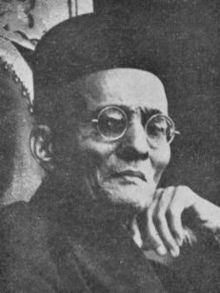Vinayak Damodar Savarkar, freedom fighter, lawyer and writer passed away in Mumbai aged 82.
V D Savarkar was an important figure in modern Indian history. It is important to know about such personalities for the UPSC exam. In today’s article, you can read about the life and achievements of V D Savarkar for IAS exam.
Aspirants can find information on the structure and other important details related to the IAS Exam, in the linked article.
| Aspirants should begin their preparation by solving UPSC Previous Year Question Papers now!!
To complement your preparation for the upcoming exam, check the following links:
|

Biography of VD Savarkar
- Vinayak Savarkar was born on 28 May 1883 to Damodar and Radhabai Savarkar in Bhagur, near Nashik in present-day Maharashtra.
- He studied in Fergusson College, Pune. He was inspired by leaders like Bal Gangadhar Tilak, Lala Lajpat Rai and Bipin Chandra Pal. He was also influenced by the protests against the partition of Bengal and the Swadeshi movement.
- He was a staunch patriot and was attracted to radical views and movements.
- After obtaining his degree, Savarkar went to England to study law. In England, he lived at India House, which was a place teeming with nationalists and political activists.
- He established the Free India Society to organise students to fight for India’s independence through a revolution. He declared, “…we want absolute independence.”
- During this time, he authored a book “The History of the War of Indian Independence” in which he described the Indian Revolt of 1857 and referred to British rule as unjust and oppressive. He became one of the first persons to allude to this revolt as India’s ‘first war of independence’. This book was banned in India but its secret publication and distribution were done.
- He envisioned a revolution along the lines of the 1857 revolt.
- Savarkar was a friend and guide to Madan Lal Dhingra who assassinated Curzon Wyllie, a British army officer. After Dhingra was executed by the British, Savarkar encouraged further revolution.
- In 1909, he led an armed revolt against the Morley-Minto reforms. Savarkar was arrested by the British for his revolutionary activities. After a trial, he was sentenced to 50-years imprisonment and deported to the Cellular Jail in the Andaman and Nicobar Islands in 1911.
- In prison, he endured, along with other inmates untold miseries and hardships. They were forced to perform hard manual labour and subjected to cruelties.
- He was released from prison after submitting four mercy petitions. The government released him but on the condition that he renounce violence. Even some Congress leaders like Mahatma Gandhi and Tilak had demanded his release.
- In 1921, he was transferred to a jail in Ratnagiri and then to the Yerwada Jail in Pune. He was released in 1924 but could not move out of Ratnagiri or engage in political activities for five years.
- He became a fierce orator and continued his writing activities. He advocated for the use of Hindi as a national language. He also fought against untouchability and caste-based discrimination.
- He became the president of the Hindu Mahasabha from 1937 to 1943.
- From February 1966, Savarkar gave up consuming food, water and medicines. According to him, giving up life when one was no longer useful to society was better than waiting for death. He died on February 26, 1966. He was also known as Veer Savarkar.
- In 2003, his portrait was unveiled in the Indian Parliament.
Some of the works of Savarkar
- Six Glorious Epochs of Indian History
- My Transportation for Life
- Kale Pani
- 1857 che Svatantrya Samar
- Maazi Janmathep
- Moplyanche Banda
- Hindu Rashtra Darshan
Also on this day
See previous ‘This Day in History’ here.
Candidates can find the general pattern of the UPSC Civil Service Exam by visiting the IAS Syllabus page.
Related Links

Comments